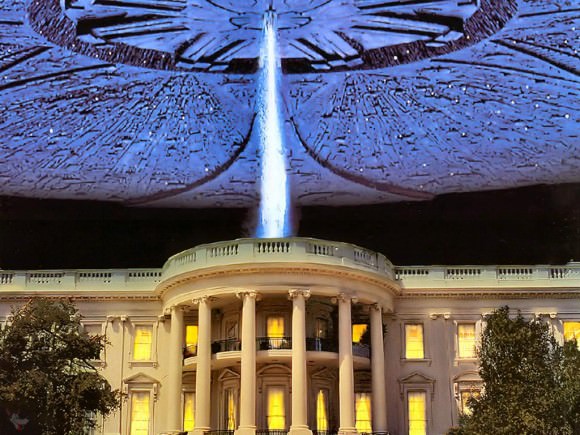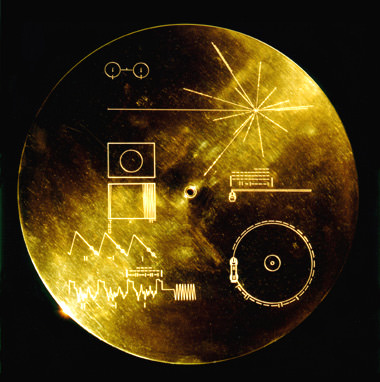Time to talk about my favorite topic: aliens.
We've covered the Fermi Paradox many times over several articles on Universe Today. This is the idea that the Universe is huge, and old, and the ingredients of life are everywhere. Life could and should have have appeared many times across the galaxy, but it's really strange that we haven't found any evidence for them yet.
We've also talked about how we as a species have gone looking for aliens. How we're searching the sky for signals from their alien communications. How the next generation of space and ground-based telescopes will let us directly image the atmospheres of extrasolar planets. If we see large quantities of oxygen, or other chemicals that shouldn't be around, it's a good indication there's life on their planet.
We've even talked about how aliens could use that technique on us. We've been sending our radio and television signals out into space for the last few decades. Who knows what crazy things they think about our "historical documents"? But Earth life itself has been broadcasting our existence for hundreds of millions of years, since the first plankton started filling our atmosphere with oxygen. A distant civilization could be analyzing our atmosphere and know exactly when we entered the industrial age.
But what we haven't talked about, the space elephant in the room, if you will, is what we'll do if we actually make contact. What are we going to say to each other? And what will happen if the aliens show up?

I'm hoping that first contact doesn't start out like this. Credit: Henrique Alvim Correa, 1906, for the novel "The War of the Worlds"
Although there's no official protocol on talking to aliens, scientists and research institutions have been puzzling out the best way we might communicate for quite a while.
Perhaps the best example is the SETI Institute, the US-based research group who have dedicated radio telescopes scanning the skies for messages from space.
Let's imagine you're a SETI researcher, and you're browsing last night's logs and you see what looks like a message. Maybe it's instructions to build some kind of dimensional portal, or a recipe book.
Whatever you do, don't try out the recipes. Instead, you need to make absolutely sure you're not dealing with some kind of natural phenomenon. Then you need to reach out to other researchers and get them to confirm the signal.

The Green Bank Telescope is the world's largest, fully-steerable telescope. The GBT's dish is 100-meters by 110-meters in size, covering 2.3 acres of space. The telescope is currently being used in a new SETI (Search for Extraterrestrial Intelligence) attempt to look for possible alien radio signals from Tabby's Star. Credit: NRAO/AUI/NSF
If they agree it's aliens, then you need to inform the International Astronomical Union and other international groups, like the United Nations, Committee on Space Research, etc.
Unless they've got some good reason to stop you, it's time to announce the discovery to the worldwide media. You made the discovery, you get to break the news to the world.
At this point, of course, the entire world is going to freak right out. Whatever you do, however, you have to resist the urge to send back a message or build that dimensional portal, no matter how much you think you understand the science. Instead, let an international committee mull it over while you stockpile supplies in a secret alien proof bunker in the desert.
What kind of message should we actually craft to our new alien penpals? Will we become fast friends, jump starting our own technological progress, or will we insult them by accident?
In 2000, and international group of SETI researchers including the famous Jill Tarter devised The Rio Scale. It really easy to use, and there's even a fun online calculator.
Step 1, figure out the class of phenomenon. Is it a message sent directly to Earth, expecting a reply? Or did we merely find some alien artifact or old timey Dyson sphere orbiting a nearby star?
Step 2, how verifiable is the discovery? Are we talking ongoing signals received by SETI researchers, or a hint in some old data that's impossible to confirm?
Step 3, how far are we talking here? Hovering over Paris? Within our Solar System, or outside the galaxy?
Step 4, how sure are you? 100% certain, and everyone agrees because they can all see that enormous mothership floating above London? Or nobody believes you, and they've locked you up because of your insane ramblings and misappropriation of government equipment?
Punch in your numbers and you'll get a rank on The Rio Scale between 0 and 10. Level 0 is "no importance" or "you're a crank", while level 10 is "extraordinary importance", or "now would be a good time to panic".

Not the best outcome. Credit: 20th Century Fox
SETI researcher Seth Shostak, calculated the Rio Scale for various sci-fi movies and shows. The first message from aliens in Independence Day would count as a 4. While the obliteration of the White House by a massive floating alien city that everybody could see would count as a 10.
the messages received in Contact, and independently confirmed by researchers around the world would qualify in the 4-8 range, while the monolith discovered on the Moon in 2001 would be a solid 6.
Now you know how important the discovery is, what do you say back to those chatty aliens?
This falls under the term CETI, which means Communications with Extraterrestrial Aliens, which shouldn't be confused with SETI, or the Search for Extraterrestrial Aliens. And it turns out, that horse has already left the stable.
When the Pioneer and Voyager spacecraft were constructed, they were equipped with handy maps to find Earth's precise location in the Milky Way.

The famous "Golden Record" carried aboard both Voyager 1 and 2 contains images, sounds and greetings from Earth. (NASA)
In 1974, Carl Sagan and Frank Drake who composed a message in alienese and broadcast it into space from the Arecibo Observatory.
In 1999 and 2003 a series of signals were transmitted towards various interesting stars. The messages contained images of Earth, as well as various mathematical principles that could be used by aliens as a common language.
We'll know if that was a good idea in a few decades.
In 2015, scientists like David Grinspoon, Seth Shostak and David Brin collected together to discuss if it's a wise idea to send messages off into space, to broadcast our existence to potentially hostile alien civilizations.
According to Seth Shostak, the best message we can send is the entire internet. Just send it all, they'll work out what we're all about.
The science fiction author David Brin thinks that's a terrible idea, and we should keep our mouths shut.
Personally, I think the aliens already know we're here. If they wanted to invade and destroy our planet, they would have done it millions of years ago when early life made it obvious this planet was inhabited. The jig is up.
It's a mind bending concept to imagine what life might be like if we knew with absolutely certainty that there's an alien civilization right over there, on that world. I'm sure people will freak out for a while, but then we'll probably just go back to life as normal. Human beings can get bored by the most surprising and amazing things.
If you learned there was definitely an alien civilization out there, how do you think humanity would respond? Let me know your thoughts in the comments.